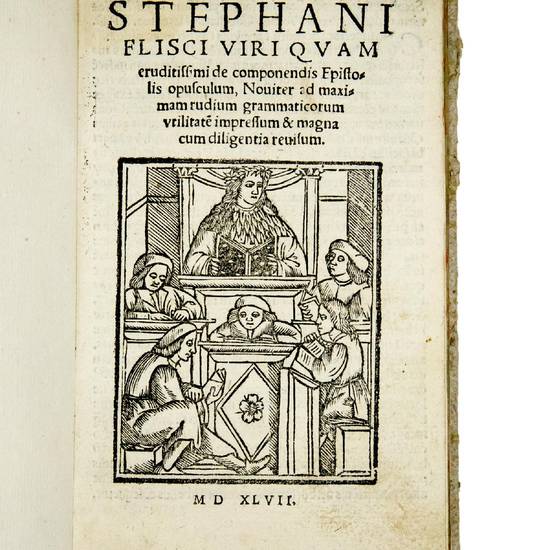8vo. (80) ll. A-K8 (K8 is a blank). With a woodcut on the title-page. Modern boards.
Edit 16, CNCE 18969; Green & Murphy, p. 204; J. Rice Henderson, On reading the rhetoric of the Renaissance Letter, in: “Renaissance Rhetoric”, H. F. Plett, ed., (Berlin & New York, 1993), p. 152.
SECOND BINDONI & PASINI EDITION, the first appeared in 1534. It was reprinted in 1553 with the same woodcut on the title-page.
Fliscus work was first printed under the title Sententiarum variationes sive Synonyma at Augsburg by Günther Zainer around 1475 with German phrase sentences and in the same year in Low-German at Cologne by Johann Koelhoff. The Italian version was first printed at Perugia in 1477, which was followed by one in Dutch (Zwolle, 1480), in French (Turin, 1481), and Spanish (Salamanca, ca. 1490). The title De componendis epistolis is first found in the edition printed at Venice by Damianus de Mediolano in 1494. The work survives in almost forty incunabular printings and over twenty sixteenth century editions (cf. A. & G. Colón, La enseñanza del latin en la Baja Edad Media: Estudio y edición sinóptica de la ‘Variationes' de Fliscus, con sus correspondencias italianas, españolas, catalanas y francesas, Madrid, 2003, passim).
“The De componendis epistolis (Venice, 1534) of Fliscus introduces itself not so much as a manual of writing letters as a set of example synonyms. Each locution is introduced in Italian, which suggests that the manual is intended for Italians attempting to acquire the ‘elegancies' of the Latin language. Significantly, the synonyms are nowhere oriented to specific addresses nor correlated to specific parts of a letter. Obviously the sort of variety exemplified in this manual is of a different sort than that to be found in dictamen manuals. As is most evident in the works of Erasmus, the goal of variety for humanists was not to present readers with a ready-made language to choose from for parts of a letter, but rather to acquaint them with the flexibility of the Latin language and provide a sample of how the student might generate his own letter” (G. Burton, From ‘Ars dictaminis' to ‘Ars conscribendi epistolis': Renaissance Letter-Writing Manuals in the Context of Humanism, in: “Letter-Writing Manuals and Instructions from Antiquity to the Present”, C. Poster & L.C. Mitchell, eds., Columbia SC, 2007, pp. 96-97).
“Le manuel est épais et offre de multiples possibilités d'entraînement. Il habitue l'élève à faire fonctionner conjointement et par commutation des structures homologues qui sont autant de paraphrases. Ce n'est ni une grammaire qui relèvrait seulement des types de contruction ni un dictionnaire référé à des structures prototypiques des mots choisis, c'est une compilation raisonnée concernant un genre littéraire, fondée sur la répétition et la diversifaction proche entre éléments répétés. Bien entendu, on est très loin du désir d'exhaustivité contemporain; le propos est uniquement celui d'entraînement pédagogique et non scientifique; mais le mécanisme est le même” (J.-C. Chevalier, La synonymie dans les manuels pédagogiques du début de la Renaissance, in: “Langages”, 31/128, 1997, p. 17).
Stephanus Fliscus was born in Soncino at the beginning of the 15th century. From his letters we know that he called himself trivii doctor. He was a student of Gasparino Barzizza, perhaps as a young man, but certainly in 1430 as he wrote in one of his letters. That is the only information we have about his education. Before studying with Barzizza, Fliscus was in Normandy where he worked from 1424 for about five years as secretary to an Italian bishop. From 1436 we can trace Fliscus in Dalmatia. In November of that year the city council of Trogir suggested that Fliscus should be appointed ‘magister et rector scollarum' for the period of two years. Council records refer to him as ‘vir peritissimus et doctissimus'. We do not know when Fliscus came to Trogir and how long he stayed there.
The next record we have about him is from Ragusa, where he was chancellor in 1441, and in 1444 became ‘rector' of the communal school. Although he held that position until 1459, we know very little about his life in Ragusa. In 1453 his father Manfredus died there after he had been living with him for a while. In the same years Fliscus wrote twelve letter ‘Ad christianos principes', warning them about the Turkish peril. In a letter addressed to the Hungarian king he spoke well about Ragusa and the Ragusans and signed it as ‘rector studii manificae comunitatis civitatis Ragusii'. All this indicate that Fliscus was probably satisfied with his position in Ragusa, where he probably stayed until the end of his life (cf. D. Mazzuconi, Stefano Fieschi da Soncino: un allievo di Gasparino Barzizza, in: “Italia medievale e umanistica”, 24, 1981, pp. 257-285).
[9140]





